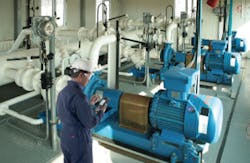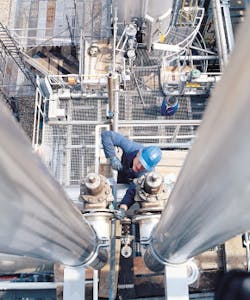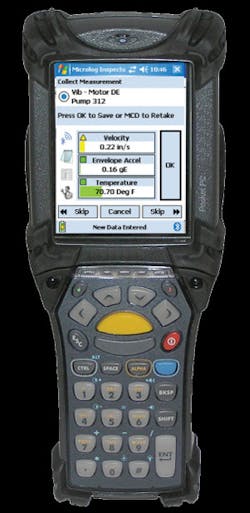Decades ago it was common practice among plant operations to wait for equipment to fail and then repair it. Generally speaking, management regarded maintenance as a necessary cost of doing business, and machinery "run to failure" was the norm. However, as time and technologies evolved—and as pressures on productivity and profitability grew—this conventional way of thinking and working began to change.
Change Begins
During the 1970s, many operations established some type of preventive maintenance program. By the 1980s, those at the forefront of best practices were employing predictive maintenance strategies and, by the 1990s, diagnostic tools, and software advanced to equip maintenance personnel with the means to ascertain timely and critical information on the operating health of machinery. Remote monitoring capabilities have since expanded capabilities.
Maintenance approaches have clearly shifted from "reactive" to "proactive" over the years, and Predictive Maintenance (PdM) programs have helped lead the charge.
By definition, PdM is a strategy to identify and repair machinery problems before they can escalate to full failure modes. Such a strategy stands in stark contrast to "time-based maintenance" or "run to failure" approaches—the direct cost of machinery repairs undertaken due to breakdowns can be at least three times greater than the cost of planned repairs, and the production outage time needed to complete an emergency repair can range up to five times more time than required for a planned repair.
In addition, according to a consulting services study focusing on motors, pumps, and bearings, approximately 40 percent of all MRO (Maintenance, Repair and Operations) expenditures is typically consumed by unplanned work, and most machinery repairs will require time-intensive detective work to arrive at the proper fix. When a solution ultimately is uncovered, the necessary replacement components—acquired during times of urgency—may be excessive, but unavoidable with the critical need to get equipment up and running without further delays.
RELATED: Plant Smarts—Making a case for investing in plant systems intelligence
More than 30 years of machinery studies have reinforced the statistic that almost 90 percent of all machinery failure modes occur randomly. But even though failure may be unpredictable, it is not undetectable. Changes in the operating conditions of equipment can help foretell when failure initially begins and whether conditions are worsening. Equipped with ample warning, operations can get ahead of the curve on problems and take proactive measures to prevent catastrophic machinery failure.
A range of predictive technologies can be engaged to detect developing machinery faults at an early stage before they can become problematic. These can include sensors, specialized monitoring devices, and analytical and data management software to capture, trend, diagnose, and report timely information on the operating conditions of machinery assets. The key to choosing appropriate predictive technologies is to understand how a particular machine fails, what symptoms will be visible and detectable before it fails, and how fast that machine will deteriorate.
Among the parameters to monitor, the analysis of machinery vibration can help chart mechanical integrity and operating health.
Turning to Vibration Analysis
Many machinery problems manifest as vibration, which is widely considered the best operating parameter to assess a machine’s condition. Vibration can detect machine fault conditions such as unbalance, misalignment, oil film bearing instabilities, rolling bearing degradation, mechanical looseness, structural resonance, soft foot, rotor bow, and cracked rotors, as well as many other fault conditions. Vibration measurements are also quick and fairly non-intrusive since the operating equipment is undisturbed.
Measuring overall vibration (the vibration level within the fixed and specific frequency range) can determine if there is an impending equipment problem by detecting an increase in overall vibration.
Typically, the user compares the overall vibration level to a predetermined alarm level and, if the alarm level is exceeded, detailed analysis is conducted to identify the fault. Specific action can then be taken before equipment failure occurs. There are also available industry standards, such as ISO, which provide allowable vibration severity levels for specific types of equipment and operating speeds. These standards can be used as guidelines to establish equipment vibration alarm levels.
A variety of hand-held vibration monitoring tools can help perform the job, ranging from low-cost vibration pens and meters measuring overall vibration levels to more sophisticated portable analyzers that collect time and frequency content of vibration along with other predictive information. These are packaged into a feature-rich, compact size with loads of storage.
Most pens and meters measure overall vibration velocity over a frequency range of 10 Hz to 1 kHz (ISO Vibration Standard 10816-1), which is considered the best range for judging rotational and structural problems (imbalance, misalignment, looseness, and stress applied to components). More sophisticated portable data collectors/analyzers collect and store machinery vibration data over several different frequency ranges (some up to 40 kHz) and display high-resolution FFT frequency spectra and time domain waveforms on a high-definition LCD screen.
Collected vibration measurements can be analyzed on the spot or downloaded to a specialized software application on a computer workstation or network for analyzing, trending long-term, and reporting abnormalities. The ability to both detect vibration problems and diagnose specific machinery faults with a portable data collector/analyzer is greatly enhanced due to their FFT spectrum analysis capabilities.
Online surveillance monitoring systems (available in hard-wired and wireless configurations) can complement the efforts, facilitating a proactive approach to reliability with round-the-clock monitoring of machinery, regardless of location. These systems collect data continuously or over a predetermined data-collection period from permanently installed sensors and then relay the findings to a host computer for analysis and/or directly to a plant’s control system for immediate action.
Turning to the Front Lines
Operations can reap significant rewards and advance the cause of PdM by turning to front-line operators and empowering them to assume proactive roles. Because of their regular proximity to equipment, operators usually will be the first to detect even the slightest changes in machinery conditions and health, including abnormal readings, odd noises, excessive heat and vibration, leaks, pressure fluctuations, and more.
Too often, however, their observations may go unreported in the absence of a system or will not be effectively acted upon—eventually leading to machine failures, unplanned downtime, and higher operating costs. An Operator Driven Reliability (ODR) program, supported by appropriate hardware and software, can provide a big assist by empowering operators and driving the reliability process.
This process relies significantly on the "eyes and ears" in a plant—the machinery operators who are in daily contact with the equipment—to help detect equipment faults before problems can escalate. Many operations have been able to increase the uptime of their pumps, processes and other machinery, and realize bottom-line benefits by implementing a carefully coordinated ODR program.
The term ODR refers to maintenance practices that are owned, managed, and routinely performed by operators. ODR encompasses operators observing, recording and responding to machine health conditions. Equally important, ODR includes teamwork and interaction with maintenance and operations departments impacting plant-wide equipment reliability.
Under ODR, operators perform basic maintenance activities above and beyond their classic operator duties. ODR enlists operators to observe and record the overall health of assets by checking for leaks, listening for noises, monitoring temperature, lubrication and vibration, and taking responsibility to identify any abnormal equipment conditions and, in some cases, respond with the appropriate corrective actions.
Increasingly sophisticated hand-held technology allows operators to translate early detection of developing problems into prompt corrective action.
For example, an advanced inspection system has been developed to integrate condition monitoring, workflow management, safety and regulatory inspections, and more in one easy-to-use system. This device automates paperless inspection routines, replacing and enhancing an existing operation’s data logging process. User-friendly input screens facilitate accurate data recording, while alarm indicators alert to abnormal conditions.
Here’s how it works: When abnormal conditions are observed and recorded, the inspection device prompts operators to undertake predetermined corrective actions. An Inspector Work Notification feature can automatically communicate operator requests for follow-up maintenance response to degrading asset conditions.
A compatible Monitoring Suite can add more value by linking operations and maintenance teams while facilitating process data analysis. Using data captured with the inspection device, such a suite can trend small process changes not yet in alarm, but possibly heading toward a problem situation as yet another indicator of machinery health. Earlier detection of abnormal conditions facilitates more time for root cause failure analysis and the flexibility to schedule maintenance at the most convenient time, thereby contributing to increased asset availability and lower inventory costs.
Case in point: A major petrochemical refiner adopted an ODR program to improve equipment reliability, enhance feedback to operators, foster cross-functional teamwork, and instill a culture of operator accountability for the equipment.
Within a year of implementation, Mean Time Between Failure (MTBF) of process pumps increased 15 percent, while pump maintenance costs decreased 12 percent. Additionally, total maintenance spending decreased 10 percent, and reliability issues identified by operators resulted in more than $350,000 in cost savings.
Overall, the ODR program helped the refiner increase revenue, reduce costs, eliminate paper rounds and redundant reporting, and enjoy prompt access to data for faster business decisions.
For some basic inspection activities, the operator may be the logically best-equipped individual (by virtue of his or her experience) to perform the task. Operators serve, in part, as well-stationed sentries who will naturally become sensitive to minor changes in a machine’s appearance, sounds, and vibrations unapparent to others. And if an operator can be empowered for adjustment and repair tasks, then minor defects can be corrected quickly before equipment has an opportunity to fail.
For any operation to realize the full potential of an ODR program, though, a team-based approach must come into play. It may be unrealistic to expect one person to be proficient and possess all the skills necessary for both plant operation and maintenance, but operators are certainly in position to emerge as key players for routine maintenance activities.
It should be emphasized that the ODR process is not intended to constitute a complete maintenance solution for any plant. In fact, there is no single "one-size-fits-all" proactive maintenance solution. ODR is best considered as a complementary practice and should represent part of a strategically applied PdM maintenance plan to achieve asset reliability and availability aligned with a company’s business objectives.
Turning to Remote Monitoring
Despite the recognized benefits of PdM programs, in general, sometimes the associated economics and logistics can become obstacles toward rollout and implementation.
Especially for smaller operations striving toward a full-blown program, the investment required for startup equipment, training, and initial support—as well as the costs associated with ongoing analysis and reporting—may be too much to carry. Even if a predictive maintenance program ultimately is outsourced to a third-party provider, issues will typically arise when timely visits must be coordinated and special safety precautions must be established, among other challenges.
Remote monitoring and diagnostics can avoid these potential pitfalls by involving an operation’s existing labor force in partnership with a provider equipped with enabling technologies and expertise to collect data about the health of machinery and deliver reliable analysis, reporting, and remedial recommendations. The outcome is often reduced risk of unplanned production stoppages and more reliable operations.
Analysis and reporting of data historically would involve the purchase of expensive software, installing it on servers maintained by an IT support group, and preserving data integrity. lt can now be performed remotely from afar by specialized providers. Operations benefit by taking advantage of cloud-based software infrastructure, supplied software, and analysis/reporting protocols.
Here is how such a system works: Machinery information and measurement data are uploaded to a "cloud" server (via the Internet), where it is stored in analyst software (available for viewing any time and anywhere from Internet access on the ground). Incoming data are reviewed continuously by a decision support system, which automatically compares the new data against known (and good) baseline measurements for possible deviations. The software flags problems and alerts a designated engineer, who reviews the data and decides on the best course of remedial action(s). A report follows with recommendations for the operation to make the fix.
Representing a truly proactive process, predictive maintenance strives continually to impart cost-effective reliability improvements. As a dynamic approach, PdM inherently demands an ongoing review of the justification for individual maintenance tasks, the efficiency with which they were carried out, and the effectiveness of those tasks on completion. Enlisting an experienced provider as an outsourced specialist—even in an initial role as adviser—can pay dividends in evaluating the existing maintenance situation, developing an action plan, implementing an integrated program supported by benefits tracking, and sustaining the adopted endeavor along the way.
Andy Hoy is director of the North American Machine Health Reporting Program at SKF USA Inc.. Mr. Hoy has been with SKF’s Reliability team for 18 years. Prior to joining SKF, he served four years as a First Class Fire Controlman on the USS Texas CGN-39. He can be reached at 267 436-6780 or [email protected].





